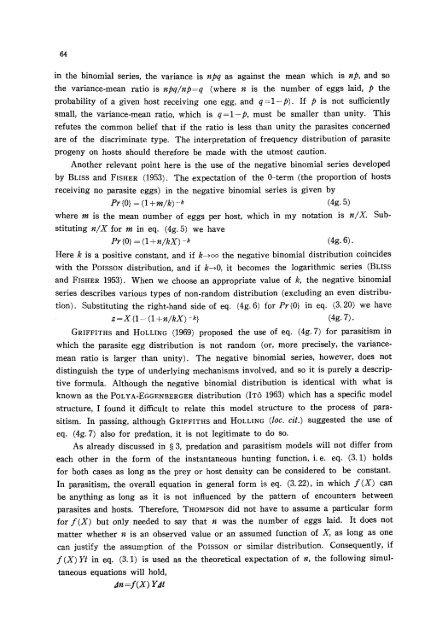A comparative study of models for predation and parasitism
A comparative study of models for predation and parasitism
A comparative study of models for predation and parasitism
Create successful ePaper yourself
Turn your PDF publications into a flip-book with our unique Google optimized e-Paper software.
64<br />
in the binomial series, the variance is npq as against the mean which is np, <strong>and</strong> so<br />
the variance-mean ratio is npq/np=q (where n is the number <strong>of</strong> eggs laid, p the<br />
probability <strong>of</strong> a given host receiving one egg, <strong>and</strong> q=l-p).<br />
small, the variance-mean ratio, which is q=l-p,<br />
If p is not sufficiently<br />
must be smaller than unity. This<br />
refutes the common belief that if the ratio is less than unity the parasites concerned<br />
are <strong>of</strong> the discriminate type. The interpretation <strong>of</strong> frequency distribution <strong>of</strong> parasite<br />
progeny on hosts should there<strong>for</strong>e be made with the utmost caution.<br />
Another relevant point here is the use <strong>of</strong> the negative binomial series developed<br />
by BLISS <strong>and</strong> FISHER (1953). The expectation <strong>of</strong> the 0-term (the proportion <strong>of</strong> hosts<br />
receiving no parasite eggs) in the negative binomial series is given by<br />
Pr{0} = (1 +m/k) --k (4g. 5)<br />
where m is the mean number <strong>of</strong> eggs per host, which in my notation is n/X. Sub-<br />
stituting n/X <strong>for</strong> m in eq. (4g. 5) we have<br />
Pr {0} = (1+ n/kX) -k (4g. 6).<br />
Here k is a positive constant, <strong>and</strong> if k-~oo the negative binomial distribution coincides<br />
with the PoISsON distribution, <strong>and</strong> if k-~0, it becomes the logarithmic series (BLISS<br />
<strong>and</strong> FISHER 1953). When we choose an appropriate value <strong>of</strong> k, the negative binomial<br />
series describes various types <strong>of</strong> non-r<strong>and</strong>om distribution (excluding an even distribu-<br />
tion). Substituting the right-h<strong>and</strong> side <strong>of</strong> eq. (4g. 6) <strong>for</strong> Pr{O} in eq. (3.20) we have<br />
z =X {1 - (1 +n/kX) - k} (4g. 7).<br />
GRIFFITHS <strong>and</strong> HOLLING (1969) proposed the use <strong>of</strong> eq. (4g. 7) <strong>for</strong> <strong>parasitism</strong> in<br />
which the parasite egg distribution is not r<strong>and</strong>om (or, more precisely, the variance-<br />
mean ratio is larger than unity).<br />
The negative binomial series, however, does not<br />
distinguish the type <strong>of</strong> underlying mechanisms involved, <strong>and</strong> so it is purely a descrip-<br />
tive <strong>for</strong>mula. Although the negative binomial distribution is identical with what is<br />
known as the POLYA-EGGENBERGER distribution (IT(5 1963) which has a specific model<br />
structure, I found it difficult to relate this model structure to the process <strong>of</strong> para-<br />
sitism. In passing, although GRIFFITHS <strong>and</strong> HOLLING (lOt, cit.) suggested the use <strong>of</strong><br />
eq. (4g. 7) also <strong>for</strong> <strong>predation</strong>, it is not legitimate to do so.<br />
As already discussed in w 3, <strong>predation</strong> <strong>and</strong> <strong>parasitism</strong> <strong>models</strong> will not differ from<br />
each other in the <strong>for</strong>m <strong>of</strong> the instantaneous hunting function, i.e. eq. (3. 1) holds<br />
<strong>for</strong> both cases as long as the prey or host density can be considered to be constant.<br />
In <strong>parasitism</strong>, the overall equation in general <strong>for</strong>m is eq. (3.22), in which f(X) can<br />
be anything as long as it is not influenced by the pattern <strong>of</strong> encounters between<br />
parasites <strong>and</strong> hosts. There<strong>for</strong>e, THOMPSON did not have to assume a particular <strong>for</strong>m<br />
<strong>for</strong> f(X) but only needed to say that n was the number <strong>of</strong> eggs laid.<br />
It does not<br />
matter whether n is an observed value or an assumed function <strong>of</strong> X, as long as one<br />
can justify the assumption <strong>of</strong> the POISSON or similar distribution. Consequently, if<br />
f(X) Yt in eq. (3. 1) is used as the theoretical expectation <strong>of</strong> n, the following simul-<br />
taneous equations will hold,<br />
,~n =f(X) Y, Jt















